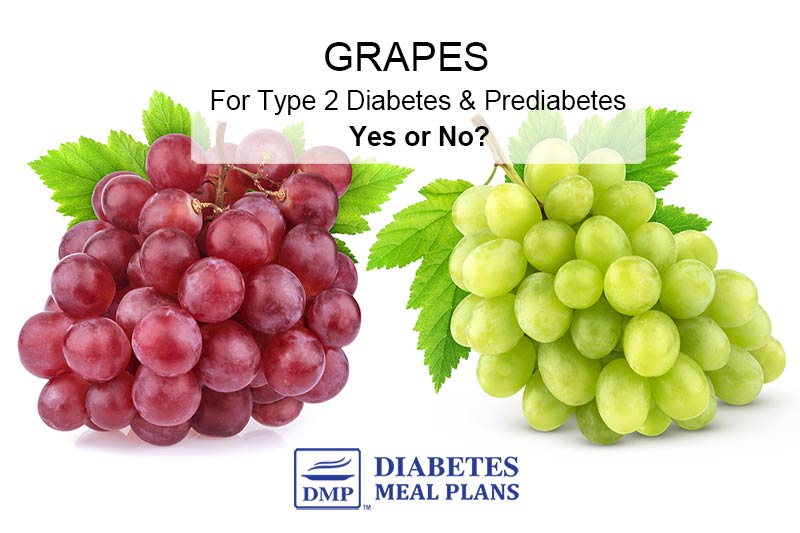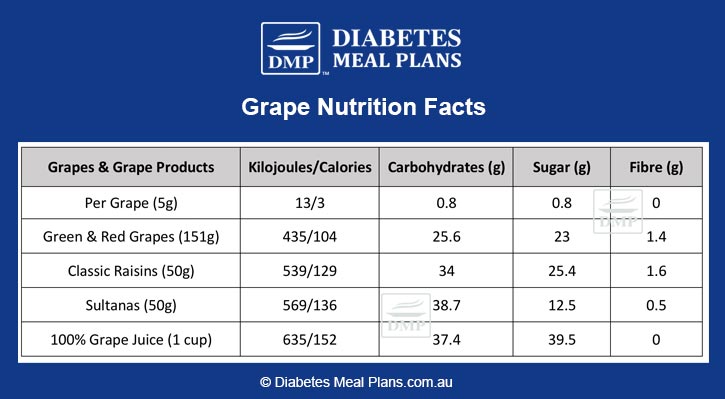A fresh clump of grapes may look beautiful on the vine, but when it comes to blood sugar management, grapes can be a disaster for people with type 2 diabetes.
Read more to learn why sugar (even too much natural sugar) can negatively affect your diabetes, and what you can eat to improve your health!
Grapes Nutrition Facts
Macronutrients
Here’s the nutrients you’ll find in 1 cup (151g) of fresh grapes:
- Kilojoules/Calories: 435/104
- Carbohydrates: 25.6g
- Sugar: 23g
- Protein: 1.1g
- Fat: 0.2g
- Fibre: 1.4g

When looking at these numbers, keep in mind that 1 cup of grapes is only about 15-20 of them.
Super sweet fruits tend to leave you wanting more, so it’s very easy to go overboard and wrack up 20-30g of straight sugar by just eating a little more than you intended to.
Grapes are a perfect example of a “simple carb” because they are low in fibre and high in sugar. Simple carbs are quickly absorbed across the small intestine and into your bloodstream, and can lead to more rapid rises in blood sugar.
That’s why we suggest to lean into complex carbs (those high in fibre)—especially non-starchy vegetables—to achieve better blood sugar levels.
Micronutrients in Grapes
Grapes do contain healthy phytonutrients like resveratrol and beta-carotene as well as several vitamins that are necessary for overall health, but grapes are not the only food that contains these nutrients.
Red and green grapes contain vitamins K, A, and C, but you also can find these vitamins in lower carb produce like spinach, leafy greens, broccoli, and citrus fruits.
Lettuce, tomatoes, and carrots are rich sources of beta-carotene and resveratrol is abundant in peanuts, pistachios, blueberries, and cranberries.
Swapping out grapes for any of these options will give you the same vital nutrients without costing you all those carbs!
Glycemic Index of Grapes
One more factor to consider about grapes is their glycemic index (GI).
Here is the glycemic index of several grape products:
- Red grapes, green grapes, and 100 % grape juice: 45
- Sultana Raisins: 57
- Raisins: 65
A moderate to high glycemic value is anywhere from 56 to 100, which puts both kinds of raisins in the red zone.
A low glycemic index is anything under 50.
Still, while the fresh grapes and grape juice has a lower glycemic index of 45 (which is technically in the low to moderate range), grapes are a high carb fruit, which is best kept in moderation, or left out of your eating plan altogether.
Glycemic index can be a helpful tool for measuring which foods are blood-sugar friendly, but it isn’t always a perfect measurement. You still have to think about the amount of sugar (carbs) you’re consuming, and how that might affect blood sugar levels. Why? Because all the carbohydrate still ends up in your bloodstream, period!
Fructose
All forms of sugar can impact blood sugar stability, but fructose can be very problematic for some people. Grapes and grape products can be very high in fructose, which explains why they taste so sweet.
A serving of fresh grapes may contain 6-7g of frutose while a serving of raisins might contain 30g or more!
Comparing Grape Products
You may also be wondering about how many carbs are in dried grapes (raisins) and grape juice. This chart compares the differences in sugar and fibre between several different grape-based products.

What do they all have in common? So much carbohydrate/sugar!
Natural or not, sugar is still sugar and there’s only one place it ends up – in your bloodstream.
Recommendation for Grapes & Type 2 Diabetes
We highly recommend staying away from the worst “sugar offenders” like raisins and grape juice, but even fresh grapes can be a problem for many people with type 2 diabetes because of the carb/sugar content.
It’s best to stick to low sugar fruits or at least be very diligent with portion control if you’re going to indulge in grapes—think, 10 or less grapes per sitting, if you do choose to eat them, which would be around 8-9g carbs.
Some great lower carb fruit options are: citrus fruit and berries of all kinds (strawberries, raspberries), as well as small portions of stone fruit like pears, cherries, and peaches.
Better yet, pair any fruit you enjoy with a hearty source of protein or fat to keep blood sugar spikes at bay and promote stability—think of unsweetened peanut butter, a slice of cheese, a hardboiled egg, or a spoonful of avocado!
Other Questions About Grapes
Are Green Grapes Lower in Sugar?
Both green and red grapes contain the same amount of carbs (sugars). One cup of each contains ~25g of carbs, so although red grapes may taste a little bit sweeter, there isn’t a significant difference in sugar content between them.

